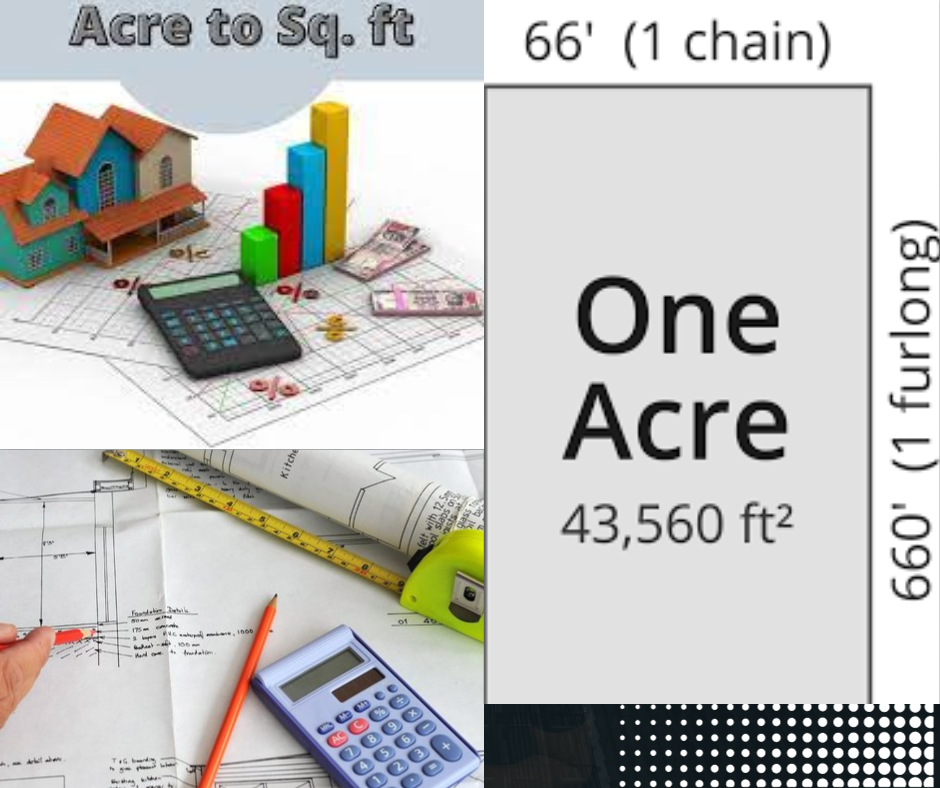Have you ever wondered how we measure land? It’s not just about the size; it’s about understanding units like an acre and its square footage. In this easy-to-understand article, we’ll unravel the mystery behind acres, explain how many square feet are in an acre, explore square footage, and discuss how this knowledge impacts various aspects of our lives
Introduction
What’s an Acre?
Have you ever heard the word “acre” and thought, “What on earth does that mean?” Well, let’s break it down in the easiest way possible.
An acre is like a big piece of land; think of it as your nature canvas. To make it less confusing, it’s about the size of a football field, including the areas at both ends of a football field. Imagine a square space, with each side measuring around 208 feet. That’s your typical acre, covering approximately 43,560 square feet.
Farmers often use acres to measure their fields. So, when someone says, “This field is five acres,” they mean it’s as big as five of those football fields we talked about.
In simpler terms, an acre is just a way of talking about land. It could be for farming, playing sports, or just having a good time outdoors. So, next time you hear “acre,” think of it as a friendly way to measure how much land we’re talking about.
Why does square matter?
Ever wondered why we talk about square feet? It’s like a language for describing space. When we say a room is 300 square feet, we’re talking about its size, like a space that’s 10 feet by 30 feet.
Why does it matter? Well, knowing square feet helps us figure out how big a place is. Whether it’s a cozy home or a roomy office, the square footage gives us a clear picture.
In real estate, it’s a big deal. More square feet often means a higher price, giving you more room for your money. So, when you hear about square feet, remember it’s not just a number; it’s a way of understanding and appreciating the space we live in.
Historical Background
Where did Acre come from?
The word “acre” has ancient origins, starting with Old English as “æcer” and evolving into Middle English as “aker.” It survived the linguistic shifts after the Norman Conquest in 1066 and became the familiar term we use today.
Back in medieval England, an acre was initially defined by the amount of land a team of oxen could plow in one day. This down-to-earth connection highlights its practical roots in agriculture.
As time marched on, the acre stuck around and found its way into everyday language and land measurement. So, the next time you hear “acre,” remember that it’s not just a unit of land; it’s a piece of history woven into our way of measuring the earth.
Changes over Time
The word “acre” has been on quite a journey! Starting as “æcer” in Old English and shifting to “aker” in Middle English, it’s been a survivor through language changes since the Norman Conquest in 1066.
Originally, an acre was tied to farming – the land a team of oxen could plow in a day. As time rolled on, its role expanded beyond agriculture, finding a place in legal and real estate lingo.
So, when you hear “acre,” think of it not just as a unit of land but as a word that’s weathered centuries, adapting alongside our ever-changing relationship with the land. The story of the acre is a piece of history told in the language of our evolving connection with the earth.
Understanding Measurements
What’s a square foot?
A square foot is like a small dance floor for measurements. It’s a way we talk about the size of a space. Imagine a square, each side being one foot – that’s one square foot.
But why should you care? Well, when we say a room is 300 square feet, it’s like a secret code for its size. Picture a space that’s 10 feet by 30 feet – that’s your 300 square feet decoded!
In everyday life, square feet are like a handy map for navigating spaces. Whether it’s a snug apartment or a sprawling backyard, understanding square feet lets you appreciate the size of the places you love.
So, the next time you encounter “square feet,” think of it as the language of dimensions, unraveling the mystery of how big or small our world can be.
Common Uses of Square Footage
Square footage is a measure of the area of a space, typically expressed in square feet (sq ft) in the United States or square meters (sq m) in many other parts of the world. The concept of square footage is widely used in various fields for different purposes. Here are some common uses of square footage:
Real Estate
Residential Properties
Square footage is a key factor in determining the value of a home. Larger homes generally have higher square footage and may be priced accordingly.
Commercial Properties
Businesses often lease or purchase office spaces based on square footage requirements.
Construction and Renovation
Material Estimation
Builders and contractors use square footage to estimate the amount of materials needed for construction or renovation projects, such as flooring, paint, and roofing materials.
Cost Estimation
Construction costs are often estimated per square foot, helping in budgeting and project planning.
Interior Design
Furniture and Decor Planning
Interior designers use square footage to plan the layout of furniture and decor to ensure optimal use of space.
Material Selection
Determining the quantity of materials like flooring, wallpaper, or paint needed for interior spaces.
Retail and Commercial Spaces
Leasing and Rental
Retailers and businesses lease commercial spaces based on square footage. Rental rates are often determined by the size of the space.
Store Layout
Retailers plan their store layouts based on square footage to create an appealing shopping environment.
Property Management
Leasing Residential Units
Property managers use square footage to advertise and determine rental rates for apartments and rental homes.
Common Area Maintenance
In commercial properties, common area maintenance fees may be assessed based on square footage.
Urban Planning
Zoning and Development
City planners use square footage in zoning regulations to control the density and type of development in different areas.
Public Spaces
Planning parks, recreational areas, and green spaces based on available square footage.
Education
Classroom and Facility Planning
Educational institutions plan their facilities based on the square footage required for classrooms, laboratories, and other functional spaces.
Healthcare
Hospital and Clinic Design
Square footage is crucial in designing healthcare facilities, including patient rooms, treatment areas, and administrative spaces.
Insurance
Property Insurance
Insurers may use square footage to determine the replacement cost of a property for insurance coverage.
Home Improvement
DIY Projects
Homeowners often use square footage to plan and execute DIY projects, such as painting, tiling, or landscaping.
Understanding and utilizing square footage is essential in various industries and aspects of daily life to make informed decisions related to space, construction, and resource allocation.
Conversions
How Many Square Feet in an Acre?
There are around 43,560 square feet in one acre. Picture a giant square, each side about 208 feet long – that’s the magic of an acre
Acre and Other Measurements
The acre is a unit of area commonly used in measuring land. Here are some comparisons with other measurements to help you understand its scale:
Square Feet
One acre is equal to 43,560 square feet. Imagine a square with sides that are approximately 208.7 feet long.
Square Meters
An acre is roughly 4,047 square meters.
Hectares
One acre is equivalent to about 0.4047 hectares.
Football Field
A standard American football field, including the end zones, is close to 1.32 acres in size.
City Block
In many urban areas, a city block is often close to the size of an acre.
Tennis Courts
About 16 tennis courts can fit into one acre.
Basketball Courts
You could fit around 104 basketball courts within an acre.
Understanding these comparisons can provide a practical sense of the size of an acre and its relationship to other common measurements of the area.
Real-Life Examples
Visualizing an Acre
The phrase “Visualizing an Acre” refers to mentally conceptualizing the size of an acre, which is a unit of area commonly used in measuring land.
An acre is equal to 43,560 square feet or approximately 4,047 square meters. To help you visualize this, consider the following comparisons:
Football Field
An American football field, including the end zones, is about 1.32 acres. So, imagine a football field, and you’ll have a rough idea of the size of an acre.
City Block
A standard city block in many cities is often close to an acre in size.
Tennis Courts
If you have ever seen several tennis courts together, they can also give you a sense of the size of an acre.
Basketball Court
Approximately 16 basketball courts can fit into one acre.
Square Plot
Picture a square plot of land that is about 208.7 feet on each side. This square would represent an acre.
These visualizations can help you grasp the scale of an acre, but keep in mind that the shape of the land can vary, as an acre can be a long, narrow strip or a more irregular shape depending on the specific measurements.
Practical Uses of Acres
Acres find practical applications across various sectors. In agriculture, farmers use acres to plan crop cultivation, while real estate relies on this unit to assess property values. From construction and landscaping to forestry and environmental conservation, acres play a crucial role in land management. They guide the planning of sports facilities, solar farms, wineries, educational campuses, and more. This unit of measurement serves as a universal tool for effective planning and utilization of land resources in diverse fields.
Stay tuned for more in this article series. We’ll dig into how acres matter in farming, real estate, and even in our ever-changing world.




Join The Discussion